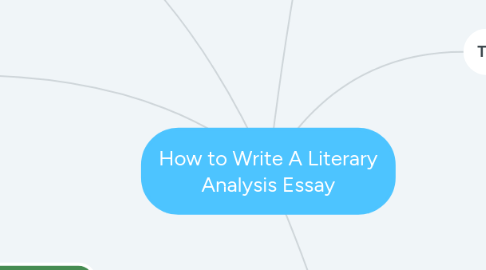How to Write A Literary Analysis Essay
Derrick Williamson IIにより

1. The Body of the Essay
1.1. The term regularly used for the development of the central idea of a literary analysis essay is the body. In this section you present the paragraphs (at least 3 paragraphs for a 500-750 word essay) that support your thesis statement. Good literary analysis essays contain an explanation of your ideas and evidence from the text (short story, poem, play) that supports those ideas. Textual evidence consists of summary, paraphrase, specific details, and direct quotations. Each paragraph should contain a topic sentence (usually the first sentence of the paragraph) which states one of the topics associated with your thesis, combined with some assertion about how the topic will support the central idea. The purpose of the topic sentence is twofold: 1. To relate the details of the paragraph to your thesis statement. 2. To tie the details of the paragraph together.
2. The Conclusion
2.1. Your literary analysis essay should have a concluding paragraph that gives your essay a sense of completeness and lets your readers know that they have come to the end of your paper. Your concluding paragraph might restate the thesis in different words, summarize the main points you have made, or make a relevant comment about the literary work you are analyzing, but from a different perspective. Do not introduce a new topic in your conclusion. Below is an example of a solid conclusion from an essay about the poem "My Last Duchess." "If the Duke has any redeeming qualities, they fail to appear in the poem. Browning's emphasis on the Duke's traits of arrogance, jealousy, and materialism make it apparent that anyone who might have known the Duke personally would have based his opinion of him on these three personality "flaws." Ultimately, the reader‟s opinion of the Duke is not a favorable one, and it is clear that Browning intended that the reader feel this way."
3. The Title of Your Essay
3.1. It is essential that you give your essay a title that is descriptive of the approach you are taking in your paper. Just as you did in your introductory paragraph, try to get the reader's attention.
4. The Thesis Statement
4.1. The thesis statement tells your reader what to expect: It is a restricted, precisely worded declarative sentence that states the purpose of your essay.
4.2. Here are some examples: 1. Gwendolyn Brooks's 1960 poem "The Ballad of Rudolph Reed" demonstrates how poet uses the conventional poetic form of the ballad to treat the unconventional poetic subject of racial intolerance. 2. The fate of the main characters in "Antigone" illustrates the dangers of excessive pride. 3. The imagery in Dylan Thomas's poem "Fern Hill" reveals the ambiguity of humans' relationship with nature.
5. The Introduction
5.1. The introduction to your literary analysis essay should try to capture your reader's interest. To bring immediate focus to your subject, you may want to use a quotation, a provocative question, a brief anecdote, a startling statement, or a combination of these.
5.2. The following is an example of a solid introduction: "The first paragraph of Alberto Alvaro Rios‟s short story “The Secret Lion” presents a twelve-year-old boy‟s view of growing up—everything changes. As the narrator informs the reader, when the magician pulls a tablecloth out from under a pile of dishes, children are amazed at the “stay-the-same part,” while adults focus only on the tablecloth itself (42). Adults have the benefit of experience and know the trick will work as long as the technique is correct. When people “grow up,” they gain this experience and knowledge but lose their innocence and sense of wonder. In other words, the price paid for growing up is a permanent sense of loss. This tradeoff is central to “The Secret Lion.” The key symbols in the story reinforce its main theme: change is inevitable and always accompanied by a sense of loss.


